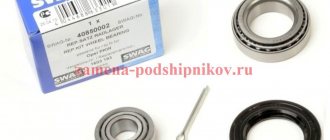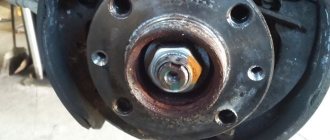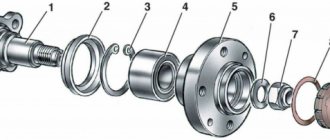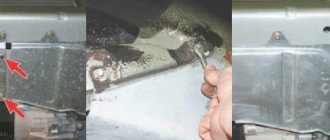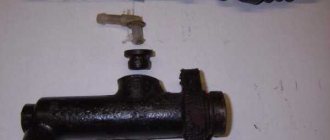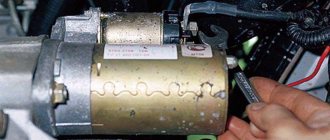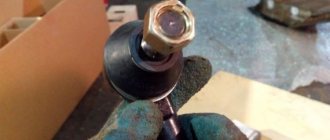What is the part used for?
Let's look at what this part is, what are the features of its design, how its malfunctions can be diagnosed and how repair work should be carried out. This part secures the vehicle wheel to the following elements:
- to the hub;
- to the steering knuckle combined into a common structure with the hub.
Since the hub is an important component of the chassis of any vehicle, providing a connection between the axle and the vehicle wheels, and wheel bearings serve as the connecting element between the hub and the axle, the rotational resistance of the vehicle wheels when using them becomes minimal.
Causes of wheel bearing failure
Original wheel bearings (which are installed on the car from the factory) can travel more than 250 thousand km. with proper use. The bearings can withstand such mileage thanks to the durable and reliable materials from which they are made. The following will lead to earlier wheel bearing failure:
- Frequently falling into potholes at high speed. When falling into holes, the entire suspension of the car experiences enormous loads, the wheel bearing is no exception;
- Overheating of the wheel bearing , for example, due to a jammed caliper or excessive tightening. If you ignore a breakdown such as a jammed brake caliper, the hub will become very hot and lubricant will leak out of it. Further operation of the wheel bearing will become impossible;
- Loss of lubricant . A very common cause of breakdown. The manufacturer usually does not put enough lubricant in cheap wheel bearings; such a bearing will last no more than 30 thousand km. If you take a high-quality wheel bearing, then over time the lubricant from it simply burns out or loses its properties;
- Wheel bearing is not properly tightened When installing a wheel bearing, you must know at what torque to tighten it. It is very important ! Do not neglect this point under any circumstances. The bearing can either be over-tightened during installation or under-tightened. If the bearing is installed incorrectly, it can last no more than 1 thousand km.
- Improper pressing of the wheel bearing. When installing a new bearing, be sure to check for any distortions. If the bearing is pressed in crookedly, the loads will be distributed unevenly. It is easy to understand that such a bearing will not last long;
- Overloading the vehicle . If you like to load your car with a massive load, know that the first thing that takes the full impact is the wheel bearing. Rest assured, such operation of the car will definitely lead to the replacement of the wheel bearing;
- Installation of wheel rims with an offset not specified by the manufacturer or installation of spacers . Discs with a large offset will also lead to premature failure of the wheel bearings. When installing such discs, the load on the wheel bearing increases significantly.
Replacing the wheel bearing.
It becomes clear that you need to avoid large potholes on the road, buy only high-quality spare parts, trust your car only to trusted professionals and operate the car correctly.
If you follow these rules, the wheel bearing will serve you for a long time.
Signs and Symptoms of a Dying Wheel Bearing
As I said, most often when it fails, the wheel bearing begins to hum at high speed. A hum in the wheel bearing appears due to the lack of sufficient lubrication. Gradually, as the bearing wears, this sound begins to appear at lower speeds. The sound will come directly from the wheel itself. It can only be confused with a faulty outboard bearing (the problem is very popular on Peugeot 307, 308) and a faulty gearbox (if, for example, there is not enough oil in it). An experienced technician can easily diagnose a faulty wheel bearing.
In addition to the hum, the wheel bearing may make a crunching or grinding noise . In such cases, the bearing warns you that it will soon seize. Such sounds indicate mechanical damage to the bearing .
Another sign of a bad wheel bearing is vibration, which is transmitted to the steering wheel and the entire car. This usually occurs within a certain speed range (for example, when driving between 60 and 80 km/h). In this case, only an experienced technician can accurately diagnose a wheel bearing malfunction, because some other faulty suspension part can transmit vibration to the steering wheel.
When the bearing is already worn out, the car may pull to the side. This situation indicates that the wheel already has significant play. In this case, it will be increasingly difficult to control the car. Operating the vehicle is strictly prohibited.
Consequences of untimely replacement of the wheel bearing.
How to identify faulty wheel bearings
There are several ways to determine if your front or rear wheel bearings are faulty. Moreover, all of them do not require special skills or specialized tools.
First of all, pay attention to the following signs of possible front or rear bearing failure:
- a hum when driving, which depends on the speed of the car, and not on the gear engaged;
- light metallic knock when driving over bumps;
- increased play in the steering wheel, its shaking when driving at high speed on a road with defects in the road surface (one of the symptoms of a faulty front wheel bearing).
The main and most obvious sign of a wheel bearing failure is a hum. Its source is determined by a fairly simple method. On a flat, straight, and preferably empty stretch of road, accelerate to a speed at which the hum occurs. After this, slightly “throw” the steering wheel left and right. If the noise intensifies when you turn the steering wheel to the right, the bearing on the right is faulty; and vice versa.
After this, we hang out the side of the car on which the faulty bearing was identified. We rotate the front and rear wheels manually, rocking them in the horizontal and vertical plane. If a slight step-like rotation is felt on one wheel, the characteristic rustling of rolling balls or rollers is heard, or there is increased play - the wheel bearing is acting up on this particular axis.
Also, one of the signs of a wheel bearing malfunction is strong heating of the hub. If you suspect problems with the wheel bearing, after the ride, carefully touch all the wheels with your hand. The hub that is noticeably hotter than the others has problems with the bearing (or brake system).
Wheel bearing fault table
N Signs of malfunction Causes of malfunction Front Rear
| 1 | The appearance of extraneous noise (low-frequency hum) in the car interior. | lack of lubrication or incorrect choice, long service life, unqualified replacement, extreme driving, the state of our roads, impacts with potholes. | |
| 2 | When driving, vibration is felt in the steering wheel or brake pedal. | Vibration only in the brake pedal. | Possible wear on the tie rod end, wear on the wheel bearing or brake disc. |
| 3 | The appearance of grease leaks on the protective cap or oil seal. | Excessive lubricant, oil seal destruction. | |
| 4 | Excessive hub heating | Insufficient lubrication, incorrect tightening torque of the hub nut. Possible depressurization of seals. | |
| 5 | Grinding and knocking noise when the suspended wheels rotate. | The ball joint, brake discs, and car suspension parts may wear out. Diagnosis is necessary. | |
| 6 | When changing speed or entering a turn, the nature of the noise changes. | Worn wheel bearings. Other unpleasant noises may change: rattling of the exhaust pipe, gearbox transfer mechanism, tire noise. | |
| 7 | Axial play of suspended wheel | The CV joint or wheel bearings fail, the wheel bolts or wheel nut are insufficiently fastened. | |
| 8 | The ABS warning light is on. | The sensor is faulty, perhaps the magnetic ring is turned the other way, probably the number of teeth on the abs ring does not correspond to the original number for this car model. | |
| 9 | Loss of controllability, the car pulls to the side. | It is possible that the tires are unevenly inflated, the wheel alignment is incorrectly adjusted, or the hub is not pressed onto the axle shaft in a coaxial manner. Drives to the right - the problem is the right wheel, to the left - vice versa. The front wheels need to be checked. | |
Important to know: If you haven’t found the source of the unhealthy noise, contact experienced drivers or service station mechanics. Professional diagnostics will not be superfluous.
Is it worth changing the element yourself?
Having determined that the problem lies precisely in the bearing, you can go to a service station or do the repair yourself if you have special skills.
But here you need to be extremely careful, set the gap correctly during installation, and also not use sharp tools that can damage the bearing seal.
When pressing the element into the hole, it is necessary to transfer force to the outer ring. When installing the bearing on the axle, you should ensure that the impact goes specifically to the inner ring.
So, we have learned how detailed diagnostics of the front wheel bearing are carried out. It must be emphasized once again that such a problem is more than serious. If a hum, play or other signs are detected, the element should be carefully checked. If you have any doubts, then you need to contact a professional or replace the faulty bearing. This way you can protect yourself from various incidents on the road.
We recommend: What are the criteria for choosing wipers?
Video on how to check the front wheel bearing:
Wheel bearing: what is checked at the service station
You can independently deliver the car to a service station, get advice on how to check the support bearing, and even watch how they fix your personal car on a lift and begin to diagnose the condition of the axle and running elements. What will a car mechanic pay attention to?
- He determines for himself the basic method of how to check a wheel bearing and applies it in the process.
- Alternately spins the wheels, first slowly, then faster. At the same time, he listens. If friction, clicking, or howling occurs, the auto mechanic looks at the location of the bearing and evaluates its external indicators.
- Wheel play is also assessed for play. To do this, the auto mechanic grabs the top of the wheel with one hand and the bottom with the other, and begins to loosen the wheel back and forth. If the tire gives way, the bearing is so worn that it requires immediate replacement. But at the same time, you should also evaluate the running parts of the machine, which may no longer operate in normal mode.
Determining the presence of backlash
To more accurately determine the situation, we will need a jack. Using such a tool, we hang the wheel, and then check whether there is any play. With one hand we take the wheel from above, and with the other from below. Let's try to rock it a little.
If play is felt, then the whole problem lies in the bearing, which must be replaced immediately.
At the same time, the appearance of play may also indicate a malfunction of one of the suspension elements. This is quite easy to check. You just need to fully depress the brake, if the play does not disappear, then the problem should not be looked for in the bearing. In addition, sometimes play indicates that the bearing is poorly secured, so it is worth checking to see if the fastening is loose.
Additionally, a video on how to check a wheel bearing will help you. You can find it on our website. The video provides detailed answers to all questions about how to check a wheel bearing:
We recommend: Why does the engine take a long time to warm up?
How to check a wheel bearing while driving
While the car is moving, if there is extraneous noise in the cabin, it becomes a hearing irritant for the driver. Finding the source of noise is sometimes difficult, because many components and parts of a machine can produce sound. Try to accelerate the car. Some tires can create a hum at high speeds, thereby misleading the driver.
You can find out which side the fault is on by maneuvering:
- Turn left, the load on the left axle will decrease, if the sound disappears or weakens, then the problem is on the left side.
- Turn to the right, the load on the left side will increase, a hum will appear, which means the assumption that the fault is on the left side is correct.
- Try varying your speed and alternating turns left and right.
- Listen to how the frequency and tone of the sound changes. It can decrease, increase, and sometimes disappear altogether.
Unbend the car on a flat road, release the gas, and move by inertia. Let the passenger listen to where the hum is coming from. Test your assumptions. Perform diagnostics on the car's wheels hanging up using a jack.
Method number 3
In this case, we will need to apply emergency driving skills. The advantage of this method is that we do not need to look for a long stretch of road and accelerate the car to high speeds. But the evenness of the coating is also important. So how do you check a wheel bearing? We accelerate the car to 20-30 kilometers per hour and begin to sharply turn the steering wheel left and right. This way we will check how much the car body rolls. The skid should increase if the wheel bearing is faulty. All this will be accompanied by a characteristic hum. On turns it intensifies significantly.
Also, in this way we can determine which side the element is faulty on. When turning right, the load goes to the left bearing (since the body moves in the opposite direction). But you can find out whether it is a rear element or a front one only on a lift.
Tips for maintenance and operation of bearings
- How to lubricate a wheel bearing.
- Keep dust away from grease and bearings. Lubrication of external surfaces prevents corrosion. For external lubrication, perform the following operations:
- First, you need to cleanly rinse the seat of the clip with kerosene, wipe it dry, then lubricate the seating surface with a thin layer of lubricant. Put on a clean rubber glove, apply lubricant to your palm and rub it into the bearing, then insert the part inside and additionally wipe the surface with a rag moistened with lubricant.
- You can use any anti-corrosion lubricant; specialized lubricants for bearing units are sold on the market. When applying, observe the amount of lubricant - there should be no leaks from the unit.
- Lubrication of the bearing inside is possible if it is open or has rubber seals. Add lubricant inside, but here you also need to follow an important rule - there should be no excess lubricant (turn the races repeatedly, excess lubricant will come out, it should be removed).
Recommended lubricant is presented in the table:
Lubricant brandsManufacturersThickenerBase oil
| RareMax AF-1 | Kyodo Yushi Co., Ltd. | Urea | Mineral oil |
| 6459 Grease N | Showa Shell Sekiyu, KK | Urea | Mineral oil |
| Pyronoc Universal N-6C | Nisseki Mitsubishi Oil Corporation | Urea | Mineral oil |
| HB-1 | Kyodo Yushi Co., Ltd. | Urea | Mineral oil |
| Ronex MP | Exxon/Mobil | Lithium | Mineral oil |
- How to extend service life.
Tighten the axle nut to the recommended torque. Excessive tension will cause excess friction, the lubricant will heat up, dry out, and the rubbing parts will become deformed. Insufficient fastening torque will cause more play than is permissible, which will lead to premature wear. Use original spare parts (nut, cotter pin, retaining ring, etc.) to repair bearings.
Which wheel bearing to choose based on manufacturer, and what to look for when purchasing.
The original number is indicated on the case; the manufacturer recommends installing it. If it is not possible to get the original, there are replacement brands. The main thing is that the dimensions and technical characteristics match. On the packaging, look at the inscriptions, barcode, stamped number on the case, and the package contents.
Wheel bearing kit - what it includes.
The repair kit includes consumable parts: wheel nuts 1 or 2 pcs., wheel bolts - set, lock ring 2 pcs. cotter pin Possible oil seals, outer races and even lubricant.
What to use a press or puller.
For high-quality work, use a press, remove the assembly, take it to a service station, and for a small fee they will replace the assembly parts in 1-1.5 hours. The puller is used when replacing independently, purchased or rented. An assistant's hand will be useful for holding the key.
Important point: Do not put pressure on the inner race of the bearing, as this can lead to damage to the elements of the bearing assembly.
ABS bearings.
The presence of an impulse ring can be easily checked by placing a metal object on one side of the seals. The magnetized side is placed inside the hole of the fist to the connector of the reading sensor.
What causes problems?
It is worth making a reservation right away and telling that the part under discussion is designed for long-term service. Its permitted mileage varies from 100 to 120 thousand kilometers. However, some car enthusiasts are capable of “killing” even such a wear-resistant device.
Let's discuss the main reasons leading to premature (starting from 70 thousand km) wear of the wheel bearing:
- Exceeding the permitted mileage disables many different spare parts, components, etc. It also affects the bearing - this is the main reason for its failure.
- The seal is broken, which means the lubricant has leaked out and your part runs dry. This very unfavorable factor will make itself felt after 2,000 km.
- Active driving and reckless driving on uneven Russian roads leads to rapid wear. In this situation, other “weak” auto parts will suffer faster, but bearings cannot be avoided.
- Uneven pressing provokes wear within 2, 3 thousand km. mileage
- Strong constriction during replacement will damage the bearing. This action causes the device to overheat and reduce its quality characteristics.
Video on the topic
Sources
- https://podtrade.ru/info/articles/stupichnye_podshipniki/
- https://family-auto.ru/stupichnyj-podshipnik/
- https://topdetal.ru/stati/kak_vyyavit_neispravnost_stupichnogo_podshipnika/
- https://zamena-podshipnikov.ru/kak-proverit-peredniy-i-zadniy-stupichniy-podshipnik.html
- https://tire1.ru/prov-stup-podship/
- https://zamena-podshipnikov.ru/zamena-podshipnika-zadney-stupicy.html
- https://AvtoNov.com/%D0%BF%D1%80%D0%B8%D0%B7%D0%BD%D0%B0%D0%BA%D0%B8-%D0%BD%D0%B5% D0%B8%D1%81%D0%BF%D1%80%D0%B0%D0%B2%D0%BD%D0%BE%D1%81%D1%82%D0%B8-%D1%81%D1 %82%D1%83%D0%BF%D0%B8%D1%87%D0%BD%D0%BE%D0%B3%D0%BE-%D0%BF/
